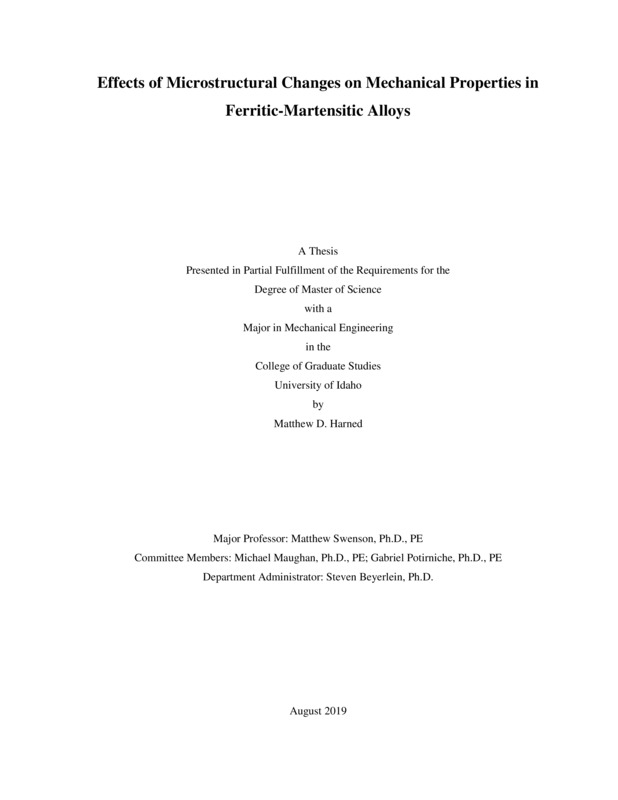Effects of Microstructural Changes on Mechanical Properties in Ferritic-Martensitic Alloys
Harned, Matthew. (2019-12). Effects of Microstructural Changes on Mechanical Properties in Ferritic-Martensitic Alloys. Theses and Dissertations Collection, University of Idaho Library Digital Collections. https://www.lib.uidaho.edu/digital/etd/items/harned_idaho_0089n_11696.html
- Title:
- Effects of Microstructural Changes on Mechanical Properties in Ferritic-Martensitic Alloys
- Author:
- Harned, Matthew
- Date:
- 2019-12
- Keywords:
- Ferritic Irradiation Martensitic Materials Microstructure Nanoindentation
- Program:
- Mechanical Engineering
- Subject Category:
- Mechanical engineering
- Abstract:
-
As an important part of the design and development of advanced nuclear fission and fusion reactors, nuclear materials research is focused on finding materials that will perform under the high temperatures, high radiation doses, and corrosive environments predicted for these reactors. Highly alloyed ferritic-martensitic steel alloys show promise as fuel cladding and reactor core structural materials for their high-temperature performance, resistance to swelling, embrittlement, and oxidation, and relatively low nuclear radioactivation.
Microstructural damage due to irradiation, including dislocation loop and cluster formation, can affect the mechanical properties. The objective of this study is to correlate irradiation-induced damage in the microstructure of two ferritic-martensitic steel alloys to a change in yield strength. Two candidate materials for use in advanced Gen IV reactors, HCM12A and HT-9, were previously irradiated with Fe2+ ions to 3 displacements per atom (dpa) at 500°C, and a sample of the HCM12A was also irradiated with to 2.4 dpa with protons. Prior published microstructural data from a transmission electron microscopy (TEM) study of the samples was used, including changes in the number density and diameter of dislocation loops and nanoclusters, and changes in the atomic concentration of various solutes in the matrix. Nanoindentation was performed on all samples to determine the change in hardness as a result of the irradiation. A quasi-static indentation technique with a Berkovich indenter tip was used, and the hardness was measured to a depth of 600 nm in each sample. A two-feature dispersed barrier hardening (DBH) model was implemented in conjunction with solid solution hardening to mathematically correlate the changes in microstructure to the changes in hardness and yield strength by solving for the strengthening coefficients of the DBH model.
In the Fe2+-irradiated HT-9, no nanoclusters were observed and thus no change in solid solution composition took place; only loops were detected, which caused an increase in yield strength of 9.3%. Loops and nanoclusters were observed in both the Fe2+- and proton-irradiated HCM12A; both linear and RSS superposition methods were used to combine the effects of loops and nanoclusters. The Fe2+-irradiated HCM12A sample experienced an increase in yield strength of 23%, and the proton-irradiated sample strength increased by 11%.
- Description:
- masters, M.S., Mechanical Engineering -- University of Idaho - College of Graduate Studies, 2019-12
- Major Professor:
- Swenson, Matthew
- Committee:
- Maughan, Mike; Potirniche, Gabriel
- Defense Date:
- 2019-12
- Identifier:
- Harned_idaho_0089N_11696
- Type:
- Text
- Format Original:
- Format:
- application/pdf
- Rights:
- In Copyright - Educational Use Permitted. For more information, please contact University of Idaho Library Special Collections and Archives Department at libspec@uidaho.edu.
- Standardized Rights:
- http://rightsstatements.org/vocab/InC-EDU/1.0/

